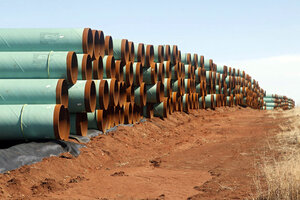Keystone XL pipeline: Nebraska’s approval puts Obama in a bind
The Nebraska governor backed the new Keystone XL pipeline plan Tuesday. A decision by President Obama about the proposal is expected to receive heavy criticism either way.

Miles of pipe ready to become part of the Keystone Pipeline are stacked in a field near Ripley, Okla.
Sue Ogrocki/AP/File
Chicago
In just the first week of his second term, President Obama is being confronted with what could become one of the most controversial decisions of his presidency: what do with the Keystone XL pipeline.
Mr. Obama put off the decision twice, citing concerns that the 1,700-mile pipeline extensions present environmental safety concerns in Nebraska. The original plans had it stretching along the Ogallala Aquifer, an underground water supply that is the greatest irrigation source to US farmland, supplying eight states. Sixty-five percent of the aquifer is in Nebraska, which makes the state ground zero in the debate over the pipeline.
The president ultimately blocked the pipeline’s approval in January 2012, which then allowed TransCanada, the operator based in Calgary, Alberta, to draft a new proposal in May.
On Tuesday, Nebraska Gov. Dave Heineman (R), who previously hesitated at approving the project, sent Obama and Secretary of State Hillary Rodham Clinton a letter saying he is now satisfied with the pipeline’s new routing. The potential environmental risks, he says, are lessened.
TransCanada is set to carry $200 million in third-party liability insurance to cover any cleanup costs, Governor Heineman says in the letter. He also writes that the proposed reroute “avoids many areas of fragile soils in Northern Nebraska” and “avoids a shallow groundwater area ... where the aquifer is thin, wells are shallow, and bedrock is close to the surface.”
The pipeline construction would generate $418 million in economic benefits to the state and about $13 million in property-tax revenues in its first year of operation, Heineman adds.
Russ Girling, TransCanada’s president and chief executive officer, released a statement Tuesday that lauded the governor’s approval, saying it moves the process “one step closer to Americans receiving the benefits of Keystone XL – the enhanced energy security it will provide and the thousands of jobs it will create.” The company, Mr. Girling also writes, added 57 special conditions to ensure the safety of the pipeline, including additional data sensors, remote-controlled shut-off valves, inspections, and maintenance.
The backing of Nebraska’s governor is seen as putting Obama in a tougher bind over a decision expected to receive heavy criticism either way. Environmental opponents view the pipeline as dangerous because it would carry oil extracted from Canada’s region of oil sands, which produce up to 30 percent more greenhouse gases than conventional crude oil. There are also worries about potential spills in the nation’s most sensitive agricultural terrain.
Danielle Droitsch, a senior attorney with the Natural Resources Defense Council in Washington, says the “two steps the Obama administration can make today to combat global warming would be to reject the Keystone XL tar sands pipeline and take measures to cut carbon pollution from power plants.” That, she adds, “would allow the US to make a serious dent to reduce carbon pollution ... while preventing more production of the dirtiest oil on the planet.”
Indeed, in his inauguration speech Monday, the president signaled a renewed interest in protecting what he described a “our natural treasure – our forests and waterways, our croplands and snowcapped peaks.” He also said, “The path towards sustainable energy sources will be long and sometimes difficult. But America cannot resist this transition; we must lead it.”
Supporters of the Keystone XL say the pipeline would generate thousands of jobs and unprecedented construction and property-tax revenues in states that could certainly benefit. To such advocates, Heineman’s support now makes Obama’s approval a “no-brainer,” says Richard Dunbar, a commissioner of Phillips County in Montana, the proposed location of the pipeline’s first substation. Mr. Dunbar says the pipeline would generate about $5 million in annual property-tax revenues for his county.
“I was glad the governor stepped up and did it. I think it answers all of our concerns in Nebraska. I hope there’s no delay in the State Department,” Dunbar says.
The US State Department is involved in the environmental review because the pipeline crosses a federal border. The agency says its review of the project is likely to extend beyond the first quarter of the year.
As for Obama’s comment regarding sustainable energy, Dunbar acknowledges that “it’s not a thing you want to hear when you want a pipeline approved.” He adds, “I don’t think we can live on green energy, not yet anyway.”
Pressure is coming from some in Washington for Obama to approve the pipeline.
“Nebraska’s approval of a new Keystone XL pipeline route means there is no bureaucratic excuse, hurdle, or catch President Obama can use to delay this project any further. He and he alone stands in the way of tens of thousands of new jobs and energy security,” House Speaker John Boehner (R) said in a statement.
The pipeline extensions would cost about $5.3 billion to construct, TransCanada says. If approved, construction would start immediately, with operations set to begin by late 2014 or early 2015.
The current Keystone system carries crude from Hardisty, Alberta, to markets in Illinois and Oklahoma. The extensions – one connecting Alberta to Steele City, Neb., and a second connecting Cushing, Okla., to refineries along the Texas Gulf Coast – would expand TransCanada’s distribution channels for heavy crude oil extracted from tar sands formations in Alberta.

